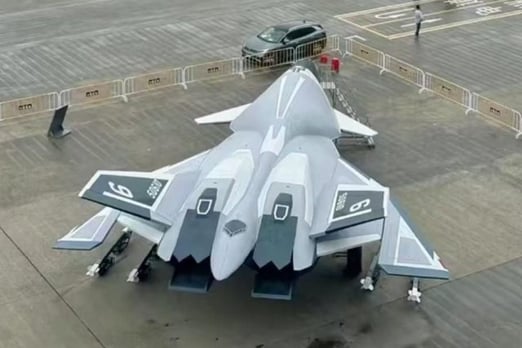China’s Sixth-Generation Fighter Jet: Redefining Aerial Dominance and Strategic Power


The unveiling of China’s sixth-generation fighter jet, tentatively named the J-36, represents a watershed moment in global military aviation. Introduced on December 26, 2024, to coincide symbolically with Mao Zedong's birthday, this state-of-the-art combat aircraft not only underscores Beijing’s advanced technological capabilities but also signals a shift in global power dynamics. With implications for strategic deterrence, military doctrine and global arms races, the J-36 stands poised to redefine aerial warfare in the coming decades.
Design and Key Features of the J-36
1. Tailless, Delta-Wing Configuration
The J-36 adopts a tailless delta-wing design, a feature characteristic of advanced stealth fighters. By eliminating the vertical stabilizers, traditionally a significant contributor to an aircraft's radar cross-section (RCS), this configuration enhances stealth while offering improved lift-to-drag ratios. The design philosophy appears to balance low observability with aerodynamic efficiency, making the J-36 both elusive to radar systems and fuel-efficient during long-range missions.
2. Tri-Engine Configuration
Unlike conventional twin-engine setups seen in fifth-generation jets like the F-22 and Su-57, the J-36 features a tri-engine configuration. This innovative design likely offers several benefits:
Enhanced thrust-to-weight ratio for sustained high-speed flight.
Increased redundancy in case of engine failure, improving survivability during combat.
The possibility of vector thrust control, enhancing maneuverability at high altitudes and low speeds, crucial in dogfights.
3. Hypersonic Capabilities
China has been at the forefront of hypersonic weapons technology, and it seems plausible that the J-36 could achieve hypersonic flight speeds exceeding Mach 5. Achieving hypersonic capability requires a delicate interplay of advanced propulsion systems, thermal management, and aerodynamics. If confirmed, the J-36’s ability to reach hypersonic speeds would render conventional missile systems less effective, as they may struggle to keep pace.
4. Advanced Stealth Technology
The low observability of the J-36 has been touted as one of its standout features. It incorporates advanced composite materials, radar-absorbent coatings, and an internal weapons bay to reduce its radar and infrared signatures significantly. This positions the aircraft as a formidable threat in contested airspace, capable of penetrating advanced air defense systems such as the U.S. Patriot or Russian S-400.
5. Artificial Intelligence Integration
A defining characteristic of sixth-generation fighters is their reliance on AI and autonomy. The J-36 is expected to incorporate an advanced AI co-pilot, capable of:
Assisting human pilots with real-time decision-making.
Controlling a swarm of unmanned aerial vehicles (UAVs).
Performing predictive threat analysis and adapting to dynamic combat scenarios.
6. Network-Centric Warfare Capability
The J-36 reportedly integrates seamlessly into China’s integrated air defense network. This connectivity allows it to:
Act as a command-and-control hub, coordinating operations across multiple platforms.
Utilize satellite-based surveillance for beyond-visual-range (BVR) engagements.
Share real-time battlefield data with naval, land and space-based assets.
7. Directed Energy Weapons
Unconfirmed reports suggest the J-36 may house directed energy weapons (DEWs) such as high-energy lasers or microwave weapons. These would provide capabilities to neutralize incoming missiles, disable enemy drones and engage electronic warfare targets without expending traditional munitions.
Strategic Implications
1. Challenge to U.S. Air Dominance
For decades, U.S. air superiority has been underpinned by platforms like the F-22 Raptor and F-35 Lightning II. The introduction of the J-36 threatens to erode this advantage, particularly in regions like the Indo-Pacific, where the balance of power is increasingly contested. The J-36’s stealth and hypersonic capabilities, combined with AI-driven systems, could neutralize traditional U.S. aerial and missile defense systems.
2. Shift in Regional Power Dynamics
The development of the J-36 reflects Beijing’s broader ambitions to assert dominance in East Asia and beyond. Its deployment is likely to:
Intensify the security dilemma in the Taiwan Strait, complicating U.S. intervention plans in the event of a conflict.
Bolster China’s position in the South China Sea, deterring freedom-of-navigation operations by the U.S. Navy.
Serve as a powerful deterrent against regional adversaries like Japan, India, and Australia.
3. Arms Race and Strategic Escalation
The unveiling of the J-36 is likely to spark an arms race in aerial warfare technology. The United States, already working on its own sixth-generation fighter under the Next Generation Air Dominance (NGAD) program, may accelerate its timeline. Similarly, Russia, Japan and European nations could ramp up their efforts to develop comparable platforms, leading to greater global instability.
Impact on Aerial Warfare Doctrine
The arrival of the J-36 necessitates a reevaluation of traditional doctrines in aerial warfare:
1. Increased Focus on Unmanned Systems
The J-36’s capability to control drone swarms highlights the growing role of autonomous systems in future conflicts. Traditional manned fighter operations may increasingly give way to hybrid strategies combining piloted aircraft with unmanned systems for force multiplication.
2. Expanded Role of Space in Warfare
With its presumed reliance on satellite-based data and long-range precision strikes, the J-36 underscores the integration of space-based assets into modern air combat. This could lead to the militarization of space, as nations seek to protect or disrupt satellite networks critical for these operations.
3. Enhanced Electronic Warfare (EW)
The reliance on network-centric operations makes the J-36 both a potent offensive platform and a potential vulnerability. Nations opposing China may invest heavily in EW capabilities to disrupt its communications and sensor systems.
Economic and Industrial Impact
1. Competition for Global Markets
The emergence of the J-36 could impact the sales of fifth-generation jets like the F-35, particularly in markets where cost-sensitive nations seek advanced capabilities. Countries in Africa, South America and parts of Asia may view the J-36 as a more affordable alternative, provided China aggressively markets it for export.
2. Strengthening China's Defense Industry
The development of the J-36 reflects the growing maturity of China’s defense industrial base. By reducing reliance on foreign technology and exporting advanced systems, China is positioning itself as a global defense supplier capable of challenging Western firms like Lockheed Martin and BAE Systems.
3. Influence on Supply Chains
The unveiling of the J-36 could influence global supply chains for rare earth elements and high-tech components. Given China’s dominance in rare earth production, the aircraft’s production may exacerbate concerns over supply chain vulnerabilities in Western defense industries.
Geopolitical Reactions
1. United States
The United States is likely to respond by accelerating its NGAD program and expanding its network of alliances, particularly through platforms like AUKUS and QUAD. Washington may also bolster investments in hypersonic defense systems, electronic warfare and AI.
2. Russia
Russia, which has been developing its own Su-57 derivative for sixth-generation capabilities, may view the J-36 as both a competitor and a potential collaborator. The two nations could deepen defense cooperation, further challenging Western airpower.
3. NATO and Allies
European nations, already grappling with budgetary constraints, may need to reprioritize defense spending to counter the emerging Chinese threat. The Tempest program in the U.K. and FCAS project in France and Germany may gain renewed urgency.
4. India and the Indo-Pacific
For India, the J-36 represents a growing threat in an already fraught security environment. New Delhi may need to expedite its AMCA program (Advanced Medium Combat Aircraft) while strengthening its defense ties with the U.S., Japan and Australia.
Future Challenges and Considerations
While the J-36 represents a technological leap, it is not without challenges:
Cost and Scalability: Developing and deploying sixth-generation fighters is prohibitively expensive, potentially straining China's defense budget.
Operational Testing: Integrating and testing such advanced technologies in real-world scenarios is complex and time-consuming.
Countermeasures: As adversaries develop hypersonic interceptors and advanced EW systems, the J-36’s effectiveness could be diminished.
The unveiling of China’s J-36 sixth-generation fighter jet is a pivotal moment in global defense, marking a new era in aerial warfare. With its cutting-edge design, hypersonic capabilities, and integration of AI, the J-36 challenges the status quo, prompting nations worldwide to reassess their strategic priorities. As the world enters this new phase of technological competition, the J-36 stands as both a symbol of China’s ambitions and a harbinger of the transformative changes reshaping the global security landscape.
The coming years will determine whether the J-36 cements China’s dominance in aerial warfare or sparks a new arms race that redefines 21st-century geopolitics.
